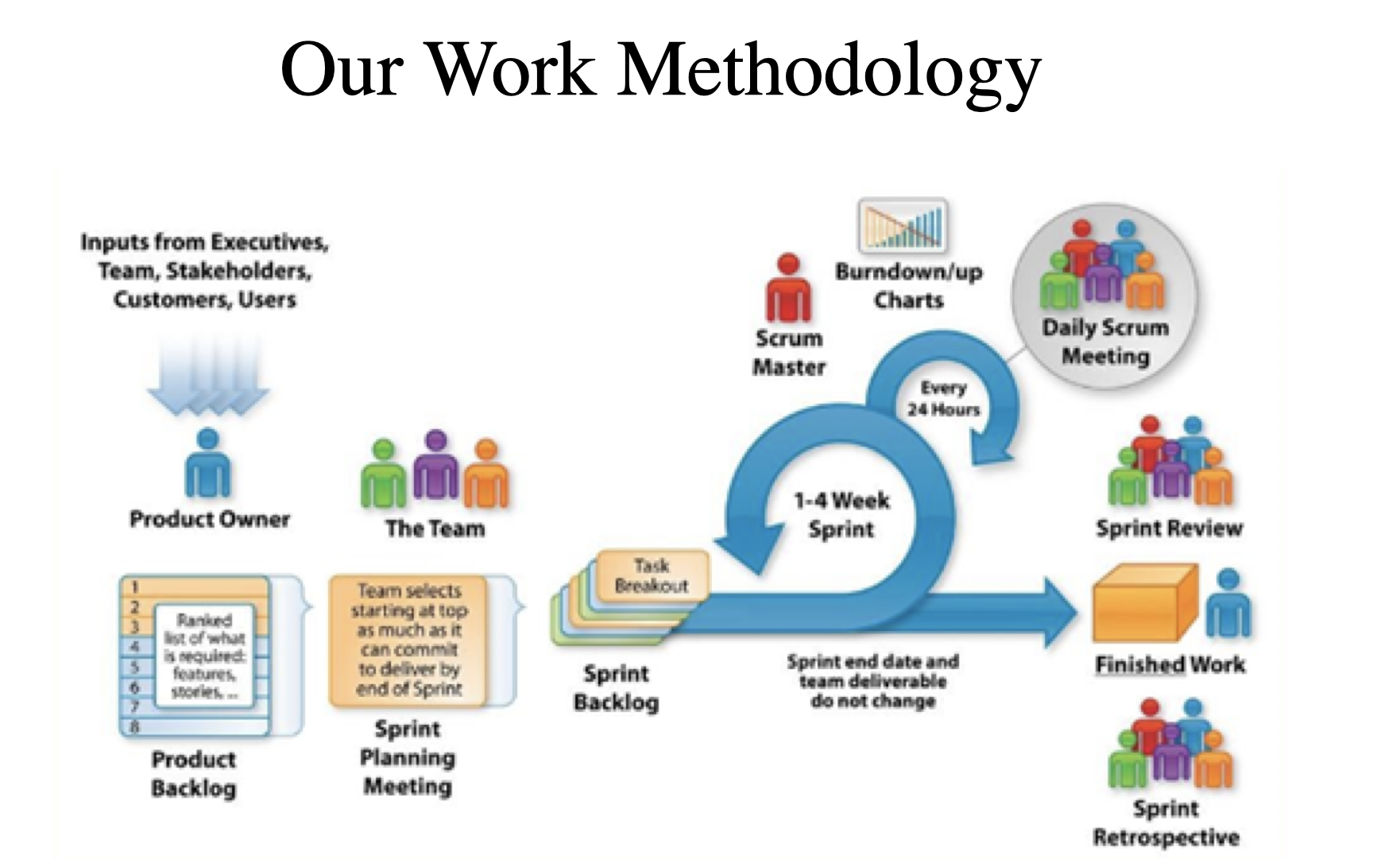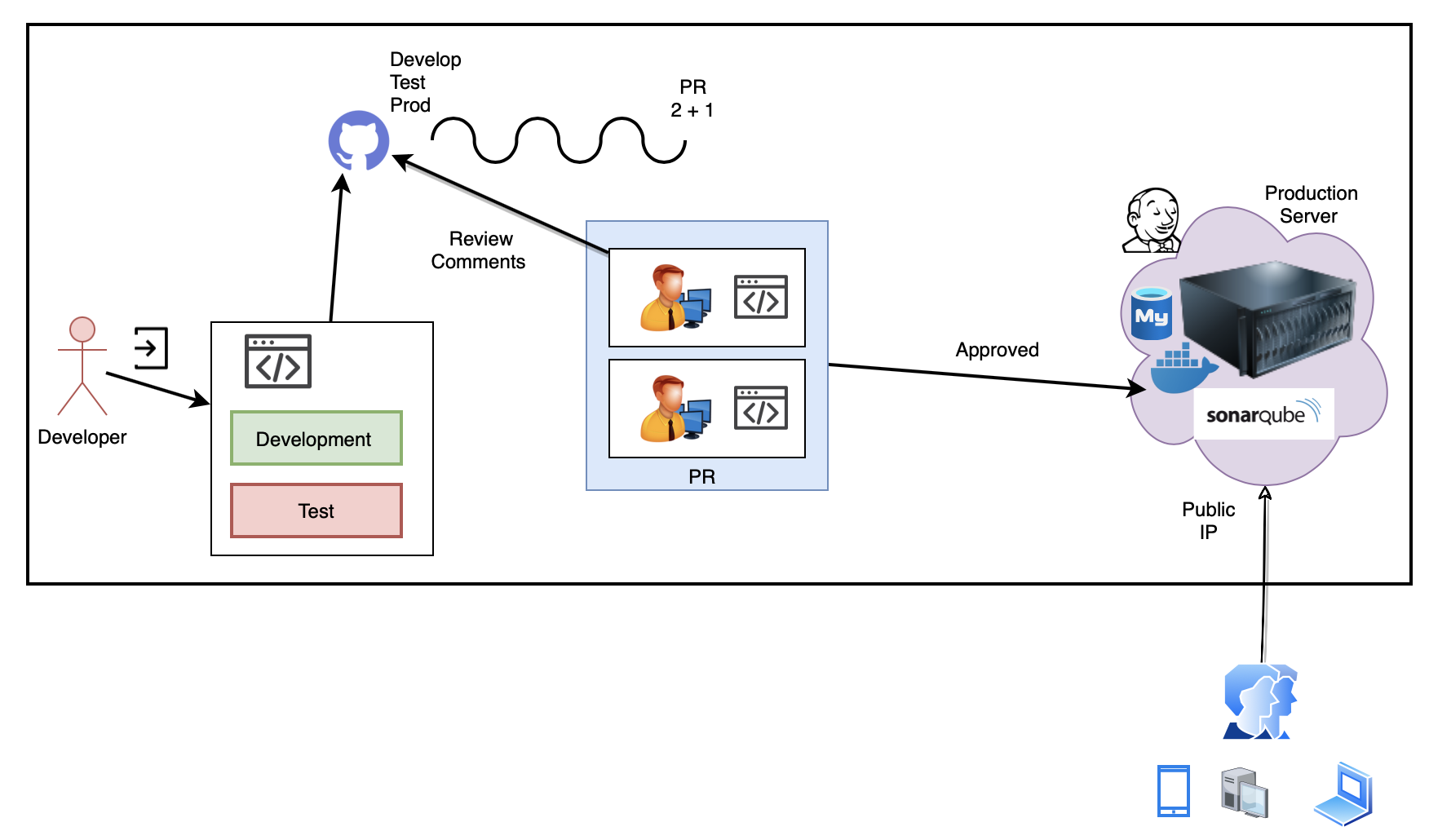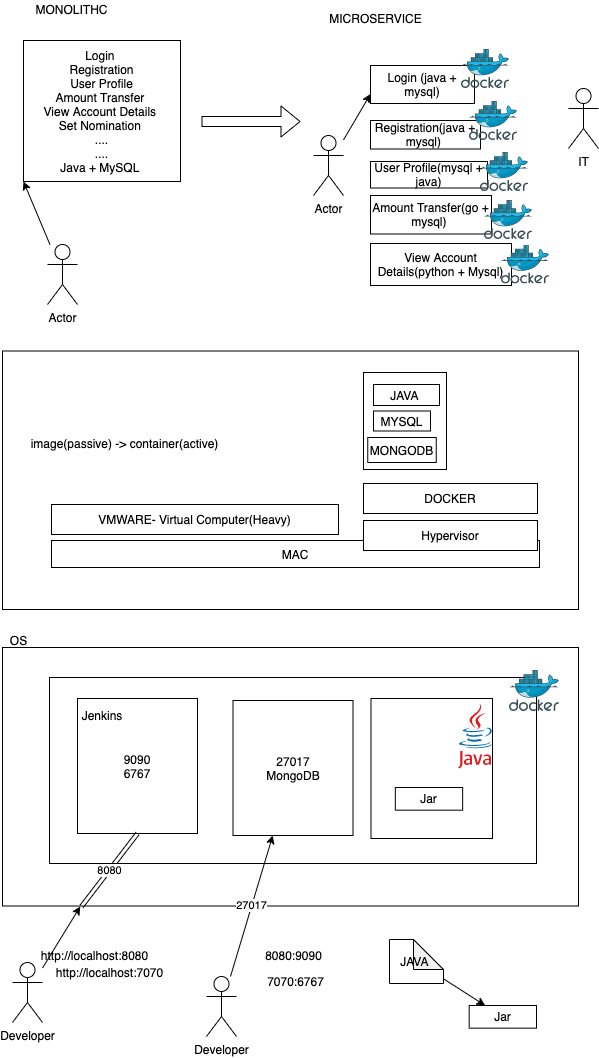Batch POC: Kanhav Ghai
Aarsh Verdan - DTU, Joined in pJP, likes to play online games, guitar, and likes to learn technology
Akhil tomar - DTU, likes : Backing Trecking, Travelling
Akshit Kumar - IIT Karagpur, playing video games, graphic designing, PS,
Aneesha Kota - IIT bhubaneshwar, play badminton, sports, singing
Bitan - IIT Bhubanesh, sudoku, likes reading a lot, watching web series one
Deepanjan - IIT Patna, CS, like to sing, swimming
Harshit singal - IIT Delhi, part of PJP, optimistic, likes to play soccer, and like playing chess
Hemanth Umanshanar - NIT Suratkat, plygin video games, watigin movies, playing guitar
Kanav Ghai - IIT Patna, likes youtube with sports, and likes eating
Karmanya Sharma - likes to learn, play football, badminton, started blogging,
Krishna - IIT Bhubaneshwar, CS, watching cricket, likes cooking
Lakshya - IIT Gandhinagar, CS, playing badminton, likes listening to music,
Prateek - IIT Kharagpur, watining movies, does cooking
Priyadarshan - DTU, CS, likes to play guitar, likes to play with dog, reads blogs
Raj Shekar - does painting, drawing , and likes to watch TV Series
Rizwan Khan - from Delhi, IIT Patna, playing cricket
Rohit - IIT Gandhinagar, ply online games, cricket watch TV Series,
Sailaja - IIT bhubaneshwar, plays badminton, mobile games
sanjana - NITK surajkal, digital art work,
Shushrut - NITK suratkal, CS, motor sport
Sioddharth - IIT Roorkey, plays any sports, watch movies, TV series, etc
pradyuman - IIT patna, plays chess, watch movies, in free time
Suhas - IIT suratkal, PC games, watch F1, football
Veena - NITK suratkal, playing basket ball, likes eating street food.
CONFLUENCE(Wiki) - JIRA - BITBUCKET
Git + GitHub / BitBucket
Jenkins (CI/CD)
LEFT -> RIGHT ( collges, they teach technologys then solve the problem) RIGHT -> LEFT (first identify the problem then the technology comes)
Work Approach
- Tech stack
- 4-5 Week of training - in that we have a small project
- 7 Weeks a full fledged project work
TDD Style - Technology BDD Style - Semi Technology GIVEN, WHEN, THEN (AND, BUT) DDD Style - Pure Business
DOR - Defination of Release
DOD - Defination of Done
List Of Softwares :
-
Git Bash : https://git-scm.com/downloads
-
Java 8 : https://www.oracle.com/in/java/technologies/javase/javase-jdk8-downloads.html
-
Jenkins : https://www.jenkins.io/download/
-
Docker : https://docs.docker.com/docker-for-windows/install/
docker run hello-world
-
Eclipse : https://www.eclipse.org/downloads/
-
VS Code : https://code.visualstudio.com/download
-
NodeJS : https://nodejs.org/en/
Either go with "master", "main"
git init
git branch -- create a branch
git checkout - checkout / switch branch
git branch --merged - to show if the current branch is merged from other branch
git branch --no-merged - to show if the current branch is not merged from other branch
git checkout main
git merge new_branch
git checkout -b dev1 (create and switch the branch)
- soft reset - will keep the file in stagin area but not commit
- mixed reset (defult) - this will take the file to untracked area
- hard reset - the content is also take off
In any case if you want to get back your code, have the commit id and you can checkout from there
The git reset command is a complex and versatile tool for undoing changes. It has three primary forms of invocation. These forms correspond to command line arguments --soft, --mixed, --hard.
git stash temporarily shelves (or stashes) changes you've made to your working copy so you can work on something else, and then come back and re-apply them later on.
In Git we have 4 area
- Untracked files
- Tracked (add)
- committed files (commit)
- stash
git stash save "message"
git stash list
git stash pop - it applied and removes
git stash apply stash@{} - applies and doesnot remove
git stash drop stash@{} - to remove the stash
git stash clear - to clear all the stash
git stash show stash@{} - to show the stash
git shash show -p stash@{} - to show the actual code
git fetch + git merge = git pull
to delete the branch on remote
git push origin --delete branch_name
git push origin :branch_name
- Freestyle project
- scripted fashion (.sh / .bat)
- Pipe line project *
- you can have groovy code in Jenkins
- You can have groovy code in "Jenkinsfile" on remote SCM
pipeline {
agent any
stages {
stage('Hello') {
steps {
echo 'Hello World'
}
}
}
}
pipeline {
agent any
tools {
// Install the Maven version configured as "M3" and add it to the path.
maven "M3"
}
stages {
stage('Build') {
steps {
// Get some code from a GitHub repository
git 'https://github.com/jglick/simple-maven-project-with-tests.git'
// Run Maven on a Unix agent.
sh "mvn -Dmaven.test.failure.ignore=true clean package"
// To run Maven on a Windows agent, use
// bat "mvn -Dmaven.test.failure.ignore=true clean package"
}
post {
// If Maven was able to run the tests, even if some of the test
// failed, record the test results and archive the jar file.
success {
junit '**/target/surefire-reports/TEST-*.xml'
archiveArtifacts 'target/*.jar'
}
}
}
}
}
mvn archetype:generate -DgroupId=com.mycompany.app -DartifactId=my-app -DarchetypeArtifactId=maven-archetype-quickstart -DarchetypeVersion=1.4 -DinteractiveMode=false
Run with PR from Master -> Dev -> branches
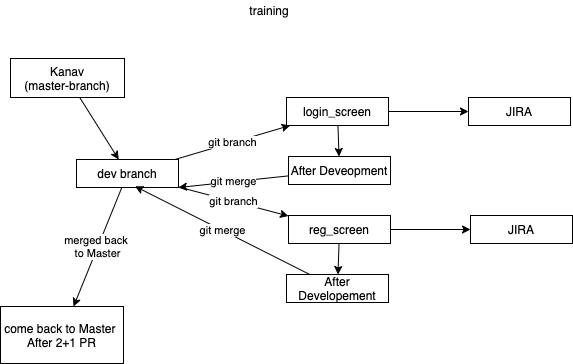
- Maven
Maven has 3 Stages
- clean (clean)
- work (various stages like compile, deploy, install, provided etc)
- report (site) - this will help you to generate the report
mvn compile
mvn clean compile
mvn package
mvn clean package
mvn test
mvn clean test
mvn site – to generate documentation
mvn clean
mvn eclipse:eclipse – compatible to eclipse
simple to program to show usage of slf4j
- Docker
Tightly Couples Loosely Cohisive -> Highly Cohisive Loosely Coupled systems
Docker allows tha orchestration with
- Docker Swarm
- Rancher
- ECS
- Kubernetees
docker info
docker images - will get all the images which are in current system
docker pull image-name - will search for the image in hub.docker.com
docker ps - active containers which are running
docker ps -a [ - active containers which are running + which are stopped]
docker rm container-id [to remove the container which is stopped]
docker rmi imageif [ to remove the images]
docker system prune [ to remove images which are not in use ]
docker stop container-id [to stop the container which is running ]
docker start container-id [to start the container ] Note: you cannot delete running container to do so first stop / force delete
docker pull mongo
docker run -name sapient-mongodb1 -d mongo
to get into the mongo instance
docker exec -it [ containerid/name ] sh
to push image to hub.docker.com
Syntax: docker push username/imageid:tag Example: docker push adithnaveen/java-image:1
docker pull jenkins
docker run --name sapient-jenkins-instance -d -p 8080:8080 -p 50000:50000 jenkins:2.7.4
docker logs [ container-id ] - to get the logs of the running container
docker inspect [container -id ] - to get the details of the container
docker history i-hello-world-3
To deploy a java application
Steps
1. docker pull openjdk
2. mvn clean install
3. copy jar file to docker container
4. java -cp target/app-snapshot.jar com.mycompany.app.App
Docker can build images automatically by reading the instructions from a Dockerfile
to build image
docker image build -t i-hello-world-4 .
to run
docker run i-hello-world-5:latest
Assignment Image
To build a pipe line for using jenkins / docker
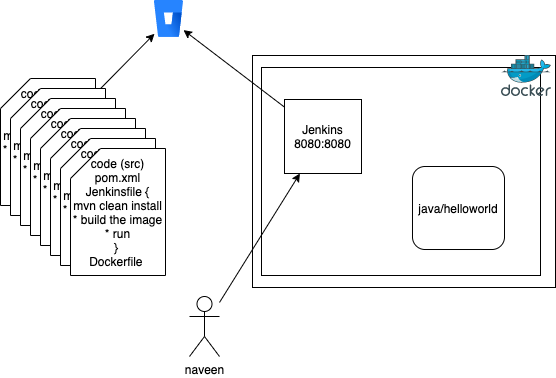
docker volume ls
docker volume create vol-name
docker volume inspect vol-name
start jenkins instance attached to volume(default)
docker run --name jenkins-container-1 -v [ vol-name ]:/var/jenkins_home -p 8080:8080 jenkins:2.7.4
start jenkins instance attached to volume - bind a folder
docker run --name jenkins-container-1 -v /users/naveenkumar/Desktop/folder-name:/var/jenkins_home -p 9000:8080 jenkins:2.7.4
Team 1 - Prateek, rajshekar, akshit, harshit
Team 2 - Deepanjan, kanav, rizwan, praduman
Team 3 - karmanya, priyadarshan, aarsh verdhan, akhil
Team 4 - krishna, aneesha, bitan, sailaja
Team 5 - rohit, laksay, shushut, siddharth
Team 6 - sanjana, suhas, hemanth, veena
- WORM (Write Once Read Many)
- Docker Volumes
- install sonar lint + object aid
- understand java program
int main() {} - you have control
void main() {} - 0
HelloWorld.java
package com.naveen;
public class HelloWorld {
static void hi() {}
void bye() {}
int x=100; - heap
static int yy=100;
boolean flag = true;
public static void main(String [] args) {
int y;
HelloWorld h = new HelloWorld();
h.bye();
hi();
System.out.println(h.x);
System.out.println("hi);
}
}
javac -d . HelloWorld.java - syntax and semantic .class - compiler / JITC java com.naveen.HelloWorld hi[0] bye[1] cya[2] - interpreter
stack calls
version 1
int main(){
hi();
}
hi(){
bye()
}
bye() {
cya()
}
cya(){}
version 1
int main(){
hi();
}
hi(){
....
}
String can hold - "10" , "true", .png .exe - mac / lin (does not work) .so / a.out - win / max (does not work) .dmg - win / lin
access specifiers
- public
- private
- protected
- default(package)
Folder Structure Training (Repo) aneesha-llid w1-d1-git-jenkins w1-d2-maven-docker w1-d3-java w1-d4-java-dp
bitan-llid
Participant 3
..
Participant n
- Differnt UML diagrams (26) types of diagram
- class diagram
- use case diagram
- activity diagram
- sequence
- profile diagram
- flow chart
- data flow diagram
- component diagram
- objecet diagram
- state diagram
- context diagram
-
HLD - High Level Diagram
- use case diagram
- flow chart
- component diagram
- context diagram
-
LLD - Low Level Diagram
- class diagram
- use case diagram
- flow chart
plantuml (explore) abstract class "abstract class" annotation annotation circle circle () circle_short_form class class diamond diamond <> diamond_short_form entity entity enum enum interface interface
OOPS - anti pattern
-
compositon - has-a
class Employee { private int empId; private Name name; private double salary; // getters / setters } class Customer { private Name name; private int custId; private double income; } class Trainer { private int tId; private Name name; private double level; } class Name { private String firstName; private String middleName; private String lastName; } -
aggregation
-
association -is-a (generalization - speciliazation)
class Vehicle {} - generic class class Car extends Vehicle {} generic class - specific class class Maruti extends Car {} - specific class -
S - Single-responsibility principle
-
O - open close - should be open for extension, but closed for modification
-
L - Functions that use pointers or references to base classes must be able to use objects of derived classes without knowing it
interface Vehilcle {
public void move();
}
class Car extends Vehicle {
public void driveStreering() {}
public void move(){}
}
class TwoWheeler extends Vehilce {
public void handle(){}
public void move(){}
}
class VehilcleBL {
public static void show(Vehicle v) {
v.move();
if(v instanceof Car) {
v.driveSteering();
}else if(v instanceof TwoWheeler) {
v.handle()
}
}
}
class App {
public static void main(String [] args) {
Vehicle v;
v = getMe("car");
VehicleBL.show(v);
v = new getMe("twoWheeler");
VehicleBL.show(v);
}
}
in C
int main() {
int *p;
p = (int *) malloc(100);
... your business logic
free(p);
}
- I - Interface segregation principle: "Many client-specific interfaces are better than one general-purpose interface"
- D - Dependency Injection (DI)/ IOC
- KISS
- DRY
- YAGNI
Below are the asks
-
The company (XYZ) who manufacures chasis / nuts/ enginee etc
-
they have a problem to integrate various cars which they are catering
-
the want a unifed system where can build "nut/bolt" for differnet cars / two / trucks
-
the code is exposed to the client but they have comeback saying its complicated to understand what is available Ex: class Vehicle {} class Car extends Vehicle{} class Maruti extends Car {}
class Breeza extends Maruti {} class Swift extends Maruti{}
class BMW extends Car {} class X1 extends BMW {} class X2 extends BMW {}
class Volve extends Car{} class VSixty extends Volvo {}
X1 x1 = new X1(); x1.showNutBolt() (wrong)
- they want a common interface where they can see size / dimention / weight of nut/ bolts
- they would like to have the data kept in matrix format
- maruti -> Breeza / Swift ...
- BMW -> X1, X2...
- Volvo - VSixty, CSixty ...
> way 1
class Brands {
private String branchName;
private List< Car > cars;
}
List<Brands> brandedCars = new List<Brands>();
Brands marutiBrands = new Brands();
marutiBrands.setBrandName("Maruti");
marutiBrands.setCars()
brandedCars.add(List.of(new Car("Breeza", 4), new Car("Swift", 5));
> way 2
HashMap<String, List<Car>> brandedCars = new HashMap<>();
brandedCars.put("maruti", List.of(new Breeza(), new Swift())
brandedCars.put("maruti", List.of(new Car("Breeza", 4), new Car("Swift", 5));
write 1 method which should show all the cars (nuts/bolts)
Convention
package - has to be in lower case & cannot be in default package * com.company.something * org.company.something
variable / methods - camelcase - start with lower case then every words first char is in upper chse
- empId, empName, debitSalary, creditSalary, getEmployeeSalaryFromDB()
class name - pascal casing
- start with upper case then every next work first char in upper case Employee, EmployeeProcessor, EmployeeDAO, IEmployeeDAO
constants * to be in upper case * COMPANY_NAME, TAX
class - contracting Abastract Class (only abstract, you can have concrete methods) / Interface (100%, concrete methods but has to be default prefixed)
Noun - Entity / Bean Employee - DB
EmployeeDAO
access-specifer access-modifier returntype methodname(param)
access-specifer - public, private, protected, default access-modifier - static, final, sychronized, abstract void or type (int, flotat, Employee, Vehicle)
class Company {}
@Data
class Employee {
private Company company;
private int empId;
private String name;
public void setCompany(Company company) {
this.company = company;
}
}
// BLR
Company company = Company.getInstance();
Employee e = new Employee();
e.setCompany(company);
e.blah()
// CHN
Company company = Company.getInstance();
Employee e = new Employee();
e.setCompany(company);
e.blah()
Vehicle
Car
BMW
X1
X2
X3
X4
..
Maruti
Swift
Kizashi
Scross..
TwoWheeler
Color
BLUE
GREEN
BLACK
WHITE
chain of rsponsitibliy
fetch(url)
.then()
.then()
.then()
.catch()
Class.forName("com.mysql.jdbc.Driver");
Project Work : StackTooFlow
User Stories:
- The application should have option to login to system
- the application should allow to register
- The application shoul allow to reset the passwor if user forgets
- The application should allow to ask a question
- There should be UP / DOWN down vote the question
- UP/DOWN on comment for the question
- the Application should allow to have comments for the question
- The application shall allow suggest similar problem
- Should allow answer the question
- Option to Delete / Edit option only for owner of questionn
- Option to Delete / Edit option only for owner of commenter
- List Trending questions
- show user dashboard which contains
- his/ her question
- his/her comments
- View his/her grade / points - rating
- System should store user profile like name,email, gender, social links etc
- application shall allow to search a question / answer - without login
- application shall allow to search on user
- view other people profile
- sort the answer based on relevence
- assign tag for the question
- user shall have the notification
- User can close the question
- spam a question / use could report the comment
- spam a user
- owner of the question can mark the answer by other user is best answer
- One use should be able to follow other users
TDD/BDD/DDD/ATD
- TDD - Test Driven Development
- BDD - Behaviour Driven Developement
- DDD - Domain Driven Development
- ADTD - Acceptance Driven testing / Development
Next 5 Years - LowCode / NoCode
TDD (FOSS - Free & Open Source)
- jUnit 4
- jUnit 5 - Jupiter -
BL - 500 ms ----- TEST - 500ms (370XX)ms -.--
<img src="./images/tdd-bdd.drawio.png" width="350">
Given - Pre Condition
When - Actual Work
Then - Post Condition
And - Multiple
But - Clause
**To run We will user JUNI**
Featue - registration module
Scenario:
Given the application is loaded
When the user clicks on "Registration Button"
And Enter valid pattern email address
And Proper pattern Password
Then show a message called "User Registered Successfully"
Sprint Ceremony - User Strories Sprint Groomming - Stake Holder / Product Owner will come and talk to developer and explain the feature file give a closure Sprint Retrospective
Cucumber Gherkin (Small Cucumber) - Ruby (on top of Java)
Ruby / Kotlin / Scala / Groovy / R - written on top of Java
types of tests
- Sanity - check everything once
- Stress - increment the count for the BL
- Functional Test - Dont test everything but specifed
- Spike Test - Give Too much load to the system
Plugin Called Lombok - getters and setters parametric / default contstructors toString
@Data @Getters @Setters @ToString
